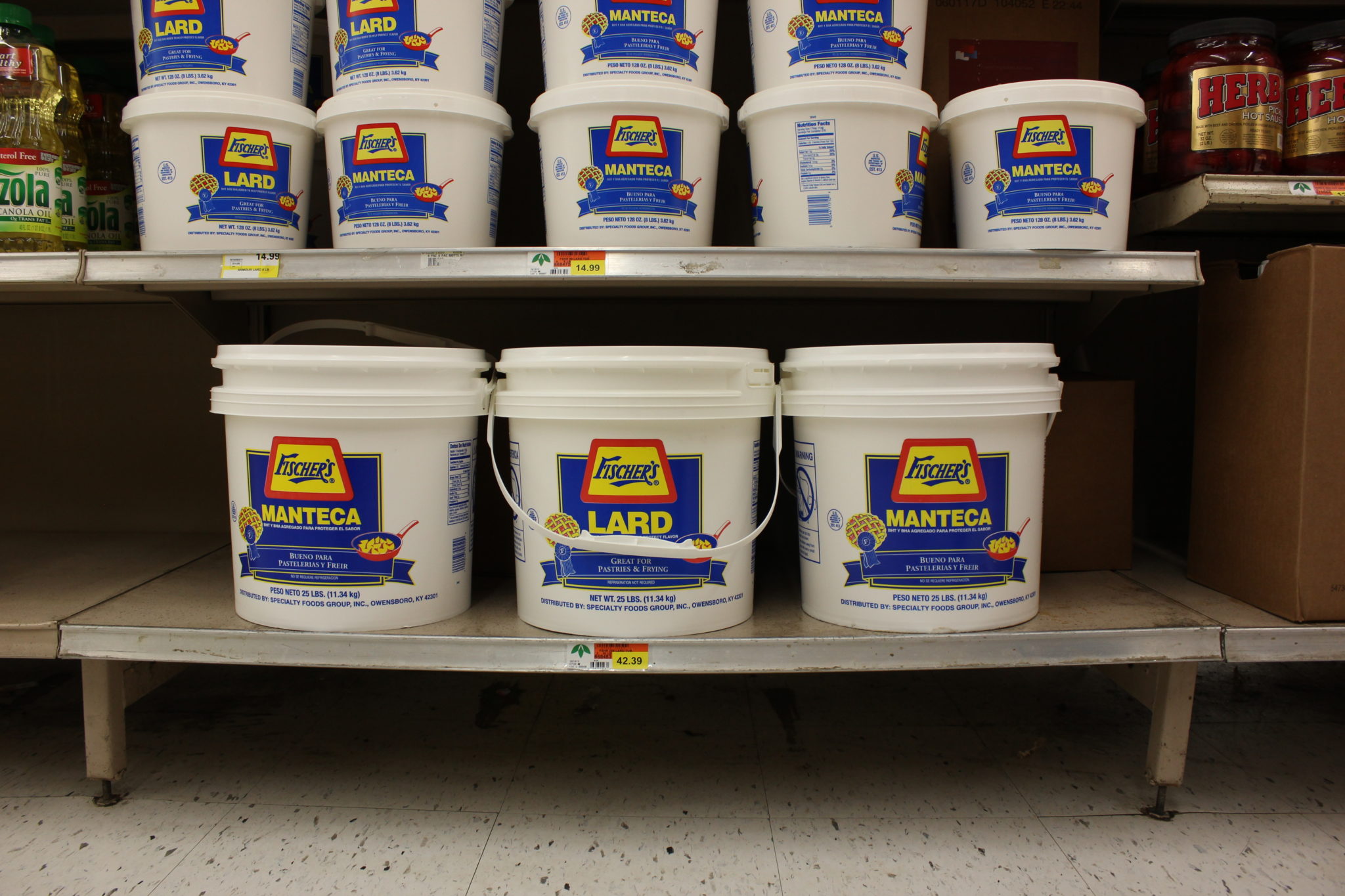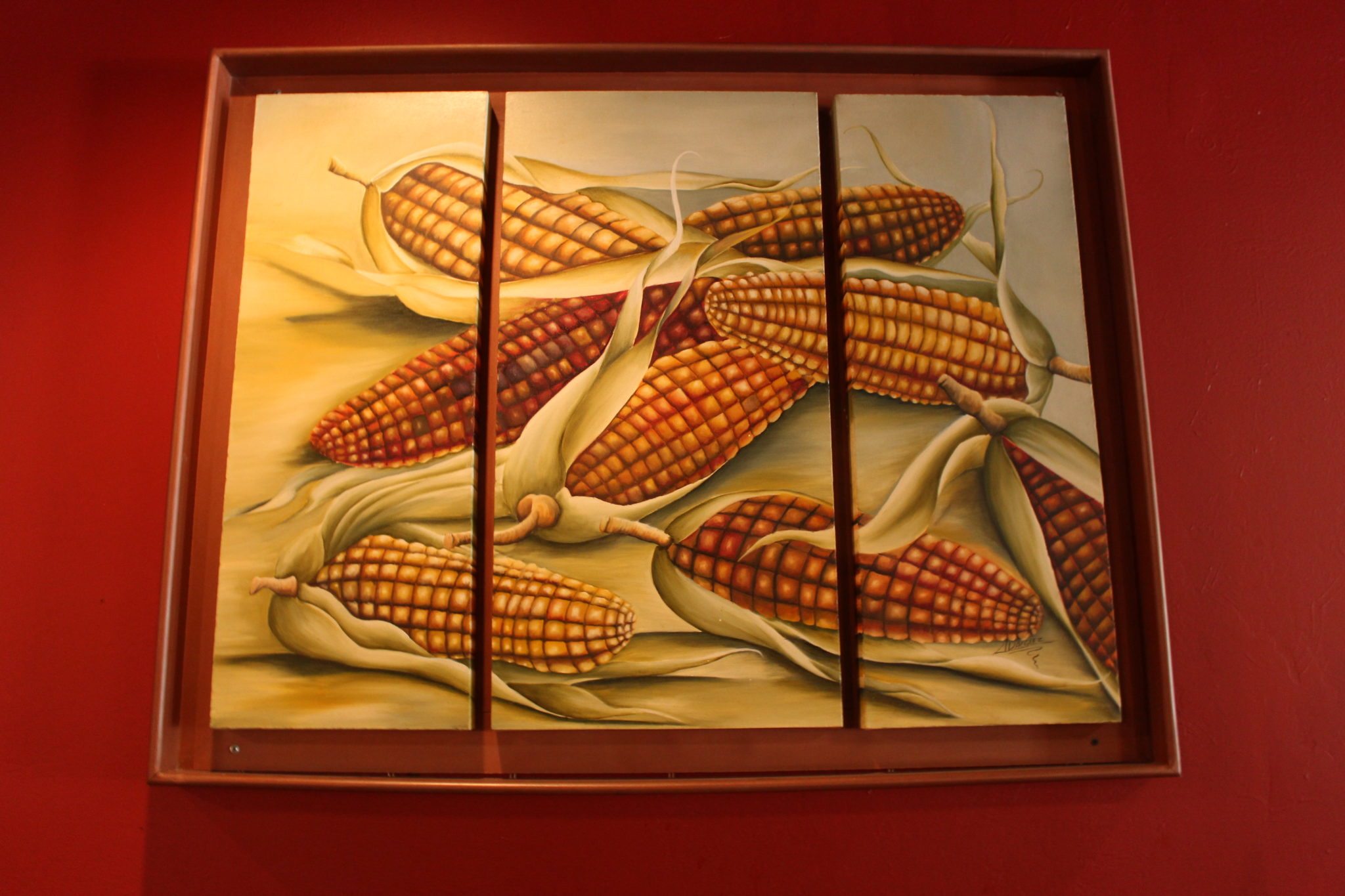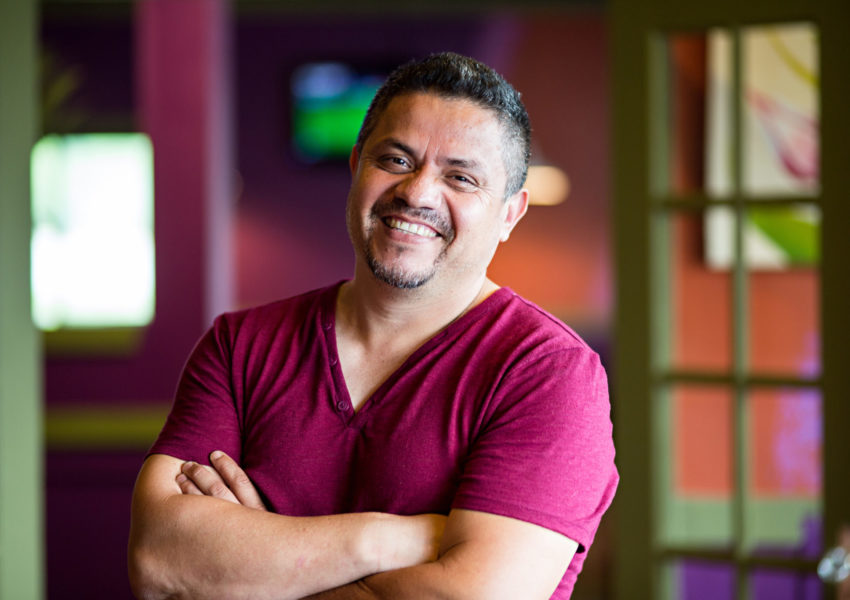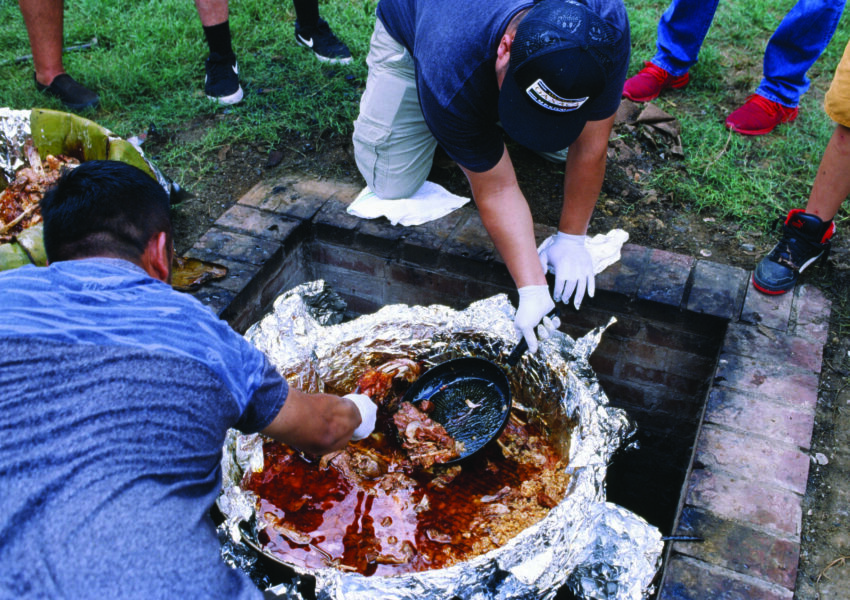Más Manteca, More Lard A Kentucky supermarket display underscores shifts in Appalachian foodways
By Lora Smith
The fluorescent lights flicker overhead. I’m standing in my favorite aisle of IGA supermarket in Manchester, Kentucky. The wall of lard, as I affectionately call it, towers five shelves high. Fischer’s, a Kentucky-based brand, dominates the shelf with one- to twenty-five-pound buckets. The cheerful tagline reads the smile-makin’ people since 1904.
![]()
Fischer’s products are full of nostalgia for me, and I’d reckon for many rural Kentuckians. Their brand shows up in many foods that working people eat with their hands. Apple and cherry hand pies fried in Fischer’s lard, their sliced pickled bologna on white saltine crackers with a shot of hot sauce on top, or their signature briny pickled egg as a late-night snack. I’ve recognized Fischer’s labels since I could sit up in the grocery buggy.
About a year ago, I noticed that the wall of lard had changed. The tubs and pails are branded identically—same Fischer’s logo, same color palette, same lattice-topped pie illustration—but now manteca is on one side and lard is on the other. Bilingual tubs of rendered fat share space in what I’d previously thought of as the “hillbilly aisle,” with its economy bags of dried pinto beans and cornmeal. Now aisle six includes bags of masa and frijoles pintos.

I’ve recognized Fischer’s labels since I could sit up in the grocery buggy.
Henry Fischer, a German immigrant, established the Henry Fischer Packing Company in Louisville. It’s no coincidence Fischer wound up in the meatpacking business. Port cities located in the Corn Belt drove a slaughterhouse boom along the Ohio River Valley in the early nineteenth century. Packing houses aggregated hogs from Kentucky, Ohio, and Indiana. After slaughter and packing, they floated down the Mississippi to New Orleans. There, the pork made its way to markets in the Deep South and overseas. Fischer’s is now owned by Specialty Foods Group, a conglomerate that oversees seven meat-focused brands. They are headquartered in Owensboro, Kentucky, another historic river and meatpacking town.

Fischer’s is still a regional brand. Each year, they sell approximately 400,000 pounds of lard in ten states that span the Ohio River Valley, central Appalachia, Michigan, North Carolina, and Alabama. Brooklyn Maple, a brand manager with Specialty Foods Group, says the company began marketing their lard with Spanish writing on one side in the late 1990s.
Kentucky has the fastest growing Latino population in the South and the second-fastest growing population in the country, with a 66 percent increase between 2007 and 2014. Most of that growth is in the central Bluegrass region. The growth is slower in Eastern Kentucky. I don’t have data to explain why, but my guess as a lifelong Eastern Kentuckian is that it’s because our economy is one of the worst in the United States. More people move out than move in.
Almost every town in Eastern Kentucky, no matter how small, has at least one Mexican restaurant. In Manchester, El Dorado is part of a micro-chain with four locations in southeastern Kentucky, a couple of storefronts down from the IGA. I stop for dinner one night on my way home from work. I am the only customer in the restaurant. I invite the manager, Antonio Lopez, to sit down with me. Lopez is in his early thirties and has a shock of black spiky hair. He is originally from Chiapas, the mountainous southernmost part of Mexico. Lopez tells me he came to the United States a little over two years ago.

I ask why we don’t have the great tortillerías or taquerías that Lexington has. “Not enough Mexicans live here to support those places,” he says. “So, we’re making the kind of Mexican food you like.” On El Dorado’s menu this includes items like jalapeño poppers, a “fiesta salad,” and “The Azteca,” a large flour tortilla filled with rice, refried beans, pico de gallo, and chicken or beef. He points to my corn tortillas. “Most people around here don’t even order those. They want flour tortillas.”
I wonder if my neighbors and I would order more off-menu dishes if we knew what they were and understood their complexity. Maybe then we’d see crock-fermented sour corn and huitlacoche as equal representations of Appalachian cuisine. Lopez tells me about the foods he eats at home. Like the best Appalachian dishes in Kentucky, the best Mexican fare in Appalachia is prepared in home kitchens, not at restaurants. Lopez does most of his personal grocery shopping at the IGA. “You can get everything there!” He adds that an entrepreneur with a truck makes weekly rounds to help restaurants stock up on spices and ingredients not readily available.
Outside of brief interactions, I don’t see Lopez or other members of the Latino community in my day to day. This is partly due to the geographic realities of a deeply rural place. I live in a holler with seven fingers. When explaining our farm to people, I use my hands to map the different drainages that come down the ridgeline, carving nooks and crannies. The land here is like origami. Hills fold in on themselves, creating creases that open up to small worlds.
I might not see my neighbors for days on end, but their labor surrounds me. The sound carries in peculiar ways, bouncing off the hills. I can be in one of our fields and all of a sudden, hear a muted conversation, the buzz of a chainsaw, or a shotgun blast. I read the noises. Someone is cutting down a tree one ridge over. Someone else just shot a deer in the pasture beyond our fence.
Back at El Dorado, I think about this while listening to the men I don’t see, the men who work in the back of the house. The clang of pots and pans and distant conversations in Spanish flow from behind closed kitchen doors into the dining room.
“In Mexico they have a saying, Sin maíz no hay país. Without corn, there is no country. The same is true in Appalachia.”
The national news describes my Appalachia as a poor region with a displaced and angry all-white and all-male workforce. Men not able or willing to adapt to a changing nation and fearful of immigrants and outsiders. The truth is that our economy has always been in flux and our people have continuously innovated and adapted to make ends meet. Much of that labor is unseen and not performed by white men. Our culture, including our agriculture and foodways, continues to adapt and evolve, too. Chef Kristin Smith of the Wrigley Taproom in nearby Corbin remembers watching her grandmother cook. “If she didn’t have one ingredient, she adapted and created a new family recipe. My chow-chow remoulade, cornmeal-crusted pork belly tacos, and chicken and dumplings ragu are all a spin on that tradition.”
Carla Gover, a musician and arts educator, grew up in Whitesburg and majored in Appalachian studies and Spanish in college. She saw the connections early on. “I was struck by how much connection I felt between these various cultures,” she says. She cites corn as a symbol of shared sustenance: moonshine, hominy, pozole, animal feed, tortillas, and cornbread. “In Mexico they have a saying, Sin maíz no hay país. Without corn, there is no country. The same is true in Appalachia.”

Last year Gover and her partner Yani Vozos, a member of the musical group Appalatin, launched Cornbread & Tortillas, a bilingual traveling festival that includes theater, music and dance performances, food, crafts, and educational workshops. The idea is to connect Appalachian heritage with Central and South American cultures to build communal understanding. For Gover, this is advocacy. “I could lecture, protest, and carry signs all day. Or I could throw a big party where we make food and play music and hearts are opened.”
I don’t know how Appalachian foodways will transform in the coming years as a result of our changing economy and demographics, but I hope it tastes like venison tamales made with Bloody Butcher cornmeal and fried Candy Roaster squash blossom tacos. What I do know is that the towns that embrace change and embrace new people, cultures, and stories, will be the communities that make it. I hope Manchester is one of those.
I linger on this thought wandering along the edges of the IGA until I’m back in aisle six, standing in front of my favorite bright wall of lard. I turn the Fischer’s tubs around to the side that reads manteca, imagining that they’d always been just that way.
Lora Smith is a founding member of the Appalachian Food Summit. In 2015, she accepted SFA’s John Egerton Prize on behalf of the organization. Smith helps grow heirloom corn, beans, tomatoes, and squash at Big Switch Farm in Egypt, Kentucky.
Photos by Ashley Melzer
Sign up for The Digest to receive Gravy in your inbox.




